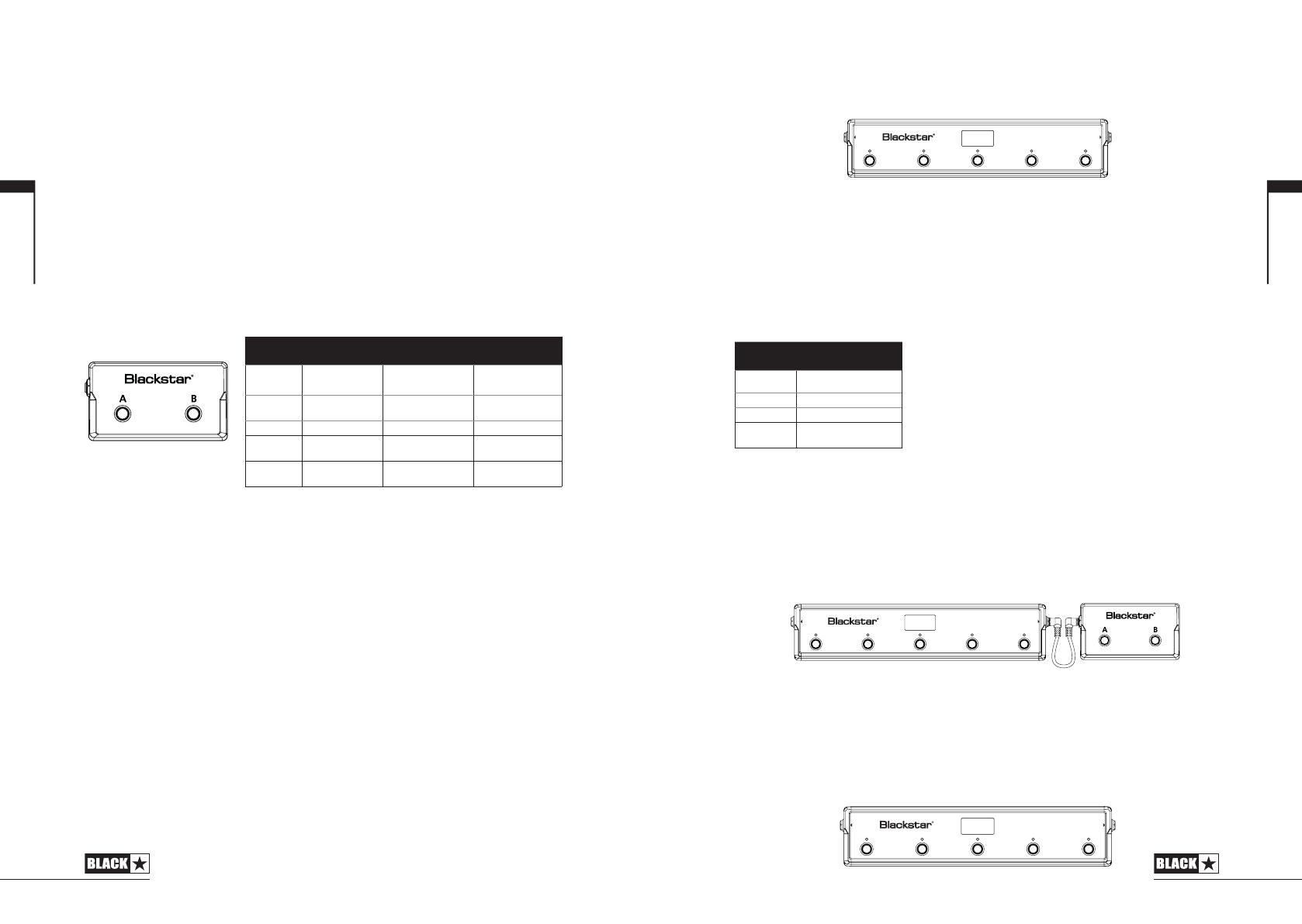
3534
Programmierbarer 5-Wege-Fußschalter FS-12 (optional erhältlich)
Schließen Sie diesen Fußschalter mit einem herkömmlichen Mono- oder
Lautsprecherkabel an der Footswitch-Buchse auf der Geräterückseite an.
Die Schalter „A“ – „C“ entsprechen den Tasten „CH 1“ – „CH 3“ auf der Vorderseite.
Drücken Sie einen der Fußschalter „A“ bis „C“, um das entsprechende Patch der
aktuellen Bank zu aktivieren. Um zwischen den Bänken umzuschalten, drücken Sie
gleichzeitig die Fußschalter „A“ und „B“ (eine Bank nach unten) bzw. „B“ und „C“
(eine Bank nach oben). Auf diese Weise lassen sich alle 36 Verstärker-Patches (12
Bänke à 3 Patches) über den Fußschalter FS-12 abrufen.
Die Schalter „D“ und „E“ am FS-12 sind programmierbar und können nach Bedarf ver-
schiedenen Funktionen zugewiesen werden. In der Voreinstellung steuern die Schalter
„D“ und „E“, wie in der folgenden Tabelle aufgeführt, die Looper-Funktion des Verstärkers.
Um diese Voreinstellung zu ändern, verbinden Sie
den Verstärker über USB mit Ihrem Computer und
stellen mit der kostenlosen Software ARCHITECT
die Optionen wie z. B. Modulation/Delay/Reverb
On/Off, Modulation/Delay Tap Tempo, Super Wide
Stereo On/Off nach Bedarf ein. Im Footcontroller-
Bereich von ARCHITECT finden Sie Details zu den
programmierbaren Funktionen.
Halten Sie „D“ und „E“ gedrückt, um den Tuner-Modus des Verstärkers zu aktivieren.
Der multifunktionale Fußschalter FS-12 beinhaltet ein chromatisches Stimmgerät mit
Noten- und Cent-Anzeige über das Display und die LEDs des Fußschalters. Durch
Drücken einer beliebigen Taste verlassen Sie den Tuner-Modus.
FS-12 + FS-13 – 7-Wege-Umschaltung
Schließen Sie den 5-Wege-Fußschalter FS-12 wie oben beschrieben an Ihren Verstärker
an und verbinden Sie dann den beiliegenden 2-Wege-Fußschalter FS-13 mit einem
herkömmlichen Mono- oder Lautsprecherkabel mit der „EXT“-Buchse Ihres FS-12.
In dieser Konfiguration können Sie zwei zusätzliche programmierbare Schalter nutzen
und über die Software Blackstar ARCHITECT konfigurieren. Im Footcontroller-
Bereich von ARCHITECT finden Sie Details zu den programmierbaren Funktionen.
In der Voreinstellung für den FS-13 schalten Sie mit Schalter „A“ den Modulations-
und mit Schalter „B“ den Delay-Effekt um. In dieser 7-Wege-Konfiguration zeigen
die beiden Symbole rechts im Display des FS-12 (wie unten dargestellt) den An-/
Aus-Status der Effekte für beide Fußschalter an.
LOOPER-MODUS
Aktion
D (drücken) Overdub wiedergeben/
aufnehmen/starten und anhalten
E (drücken) Wiedergabe anhalten/abbrechen
E (halten) Loop-Speicher löschen
D + E (drücken) Letztes Overdub rückgängig
machen
FS-12 FS-13 (im Lieferumfang)
ABCDE
AMP EXT.
ABCDE
AMP EXT.
ABCDE
AMP EXT.
Reamping
Über die ARCHITECT-Software von Blackstar kann der Verstärker in den Reamping-
Modus versetzt werden. Hierbei handelt es sich um eine nicht-programmierbare
Einstellung, die deaktiviert wird, wenn wahlweise das USB-Kabel entfernt oder der
Verstärker ausgeschaltet wird.
Wenn der Reamping-Modus aktiv ist, kann ein bereits aufgenommenes, unbear-
beitetes Gitarrensignal über USB in den Verstärker gespeist und als bearbeitetes
Audiosignal wieder abgegriffen werden. Dieses Return-Signal kann nun über die
Recording-Software im angeschlossenen PC oder Mac aufgenommen werden.
Fußschalter
2-Wege-Fußschalter FS-13 (im Lieferumfang)
Schließen Sie diesen Fußschalter mit einem herkömmlichen Mono- oder
Lautsprecherkabel (im Lieferumfang) an der Footswitch-Buchse auf der
Geräterückseite an.
In der Voreinstellung ist für den Fußschalter FS-13 der Looper-Modus (siehe Tabelle
oben) aktiv. Schalter „A“ startet/beendet dabei die Aufnahme von Loops und
Overdubs und Schalter „B“ stoppt die Loop-Wiedergabe bzw. beendet die aktuelle
Overdub-Aufnahme. Ein einmaliges gleichzeitiges Auslösen der Schalter „A“ und „B“
macht die letzte Overdub-Aufnahme rückgängig. Halten Sie Schalter „B“ gedrückt,
um den Loop-Speicher zu löschen.
Halten Sie die Schalter „A“ und „B“ drei Sekunden lang gedrückt, um den Fußschalter
in den Patch-Modus zu versetzen. In diesem Modus schalten Sie mit Schalter „A“ in
der aktuellen Bank zwischen den Patches von Kanal 1 und 2 um. Mit Schalter „B“
blättern Sie „nach oben“ durch die ersten drei Bänke, so wie Sie es über die BANK-
Taste auf der Vorderseite des Verstärkers tun würden. Den Patch-Modus können
Sie über die Software Blackstar ARCHITECT wie in der Tabelle oben aufgeführt um-
schalten. Halten Sie erneut die Schalter „A“ und „B“ drei Sekunden lang gedrückt,
um zum Looper-Modus zurückzukehren.
Der aktive Modus des Fußschalters FS-13 wird beim Ausschalten des Verstärkers
gespeichert und beim Einschalten wiederhergestellt. Wenn Sie den Fußschalter mit
angeschlossenem Fußschalter FS-13 einschalten (oder den FS-13 an den einge-
schalteten Verstärker anschließen), zeigen die blinkenden LEDS MANUAL, BANK,
CH1, CH2 und CH3 den aktiven Fußschalter-Modus an. Im Looper-Modus blinken
die LEDs der Reihe nach in der Schleife, im Patch-Modus blinken diese LEDs alle
zweimal gleichzeitig und leuchten dann wieder wie zuvor.
LOOPER-MODUS PATCH-MODUS
Aktion Umschalten Blättern
A (drücken)
Overdub wiedergeben/
aufnehmen/starten und
anhalten
Patch umschalten (zwischen
CH1 und CH2 der aktiven
Bank)
Vorheriges Patch laden
(1-12)
B (drücken) Wiedergabe anhalten/
abbrechen Zur nächsten BANK blättern Nächstes Patch laden
(1-12)
B (halten) Loop-Speicher löschen - -
A + B (drü-
cken)
Letztes Overdub
rückgängig machen - -
A + B (halten) PATCH-Modus
aktivieren LOOPER-Modus aktivieren LOOPER-Modus aktivieren
Deutsch
Deutsch










































